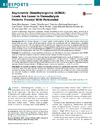Identificador persistente para citar o vincular este elemento:
https://accedacris.ulpgc.es/handle/10553/49316
| Título: | Asymmetric Dimethylarginine (ADMA) Levels Are Lower in Hemodialysis Patients Treated With Paricalcitol | Autores/as: | Oliva-Damaso, Elena Oliva-Damaso, Nestor Rodriguez-Esparragon, Francisco Payan, Juan Marañes, Alberto Parodis, Yanet Baamonde-Laborda, Lopez Eduardo Diaz, Nicanor Vega Rodriguez-Perez, Jose Carlos |
Clasificación UNESCO: | 320506 Nefrología | Palabras clave: | Asymmetric dimethylarginine Dialysis ESRD Hemodialysis Paricalcitol |
Fecha de publicación: | 2017 | Publicación seriada: | Kidney International Reports | Resumen: | Introduction:Chronic kidney disease is a major public health problem. In the last decade, it has beenshown that the early stages of chronic kidney disease are associated with an inflammatory conditioninvolving an increased risk of cardiovascular morbidity and long-term mortality. In patients with chronickidney disease and more specifically those on hemodialysis, cardiovascular events are the most commoncause of death. Asymmetric dimethylarginine (ADMA) is an endogenous inhibitor of nitric oxide synthaseand may be an independent risk factor for endothelial dysfunction and cardiovascular disease.Methods:We performed a cross-sectional analysis to identify factors that were associated with ADMAsuch as certain medications related to cardiovascular disease in dialysis patients.Results:Patients who were treated with paricalcitol had significantly lower levels of ADMA (0.21 0.19mmol/l) compared with those not treated with paricalcitol (0.42 0.35mmol/l) (P¼0.00027). Dividing ADMAlevels by quartiles, patients treated with paricalcitol were less likely to have very high level ADMA(P¼0.014), whereas there were no significant differences with other medications. Higher dose of paricalcitolwas also related to lower levels of ADMA noting an inverse correlation (r¼–0.36,P¼0.013).Discussion:Hemodialysis patients treated with paricalcitol presented significantly decreased ADMA levelscompared with those who did not receive this treatment. Possible beneficial effects in terms of cardio-vascular morbidity and mortality by paricalcitol and its association with ADMA and nitric oxide synthesisare unknown. Studies to confirm this effect and determine the underlying pathophysiological mechanismare necessary. | URI: | https://accedacris.ulpgc.es/handle/10553/49316 | ISSN: | 2468-0249 | DOI: | 10.1016/j.ekir.2016.10.002 | Fuente: | Kidney International Reports[ISSN 2468-0249],v. 2(2), p. 165-171 |
| Colección: | Artículos |
Citas SCOPUSTM
8
actualizado el 08-jun-2025
Citas de WEB OF SCIENCETM
Citations
7
actualizado el 08-jun-2025
Visitas
144
actualizado el 04-ene-2025
Descargas
124
actualizado el 04-ene-2025
Google ScholarTM
Verifica
Altmetric
Comparte
Exporta metadatos
Los elementos en ULPGC accedaCRIS están protegidos por derechos de autor con todos los derechos reservados, a menos que se indique lo contrario.
